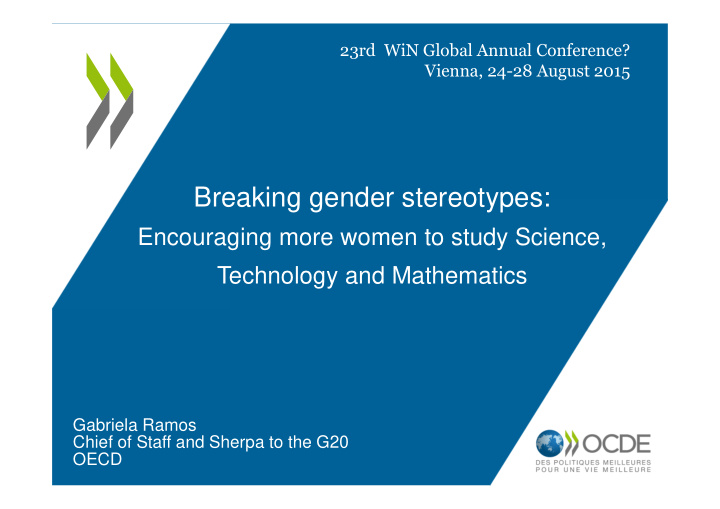



23rd WiN Global Annual Conference? Vienna, 24-28 August 2015 Breaking gender stereotypes: Encouraging more women to study Science, Technology and Mathematics Gabriela Ramos Chief of Staff and Sherpa to the G20 OECD
Men and women do not study and start their careers in the same fields Percentage of tertiary qualifications awarded to women in tertiary-type A and advanced research programs, by field of education (2012, OECD average) % 100 75 50 25 0 All fields Education Life sciences Mathematics and Physical sciences Computing Health and welfare Humanities and arts Social sciences, business Agriculture Services manufacturing and Engineering, construction statistics and law Source: OECD (2014) Education at a Glance 2014, Table A3.3
15-year-old girls are less confident than boys in their ability to do mathematics …. OECD average % Boys Girls 80 70 60 50 40 30 20 10 0 I am just not good at I get good marks in I learn mathematics I have always In my mathematics mathematics mathematics quickly believed that class, I understand mathematics is one of even the most my best subjects difficult work Source: OECD (2015) The ABC of Gender Equality in Education , Figure 3.9
… and in their ability to learn science (despite equal proficiency in science tests) OECD average % Boys Girls 80 70 60 50 40 30 20 10 0 Learning I can usually give I learn school School science When I am being I can easily advanced school good answers to science topics topics are easy for taught school understand new science topics test questions on quickly me science, I can ideas in school would be easy for school science understand the science me topics concepts very well Source: OECD (2015) The ABC of Gender Equality in Education , Figure 3.8
Parents are more likely to expect sons rather than daughters to enter STEM careers – even when they perform equally well in school Percentage of students whose parents expect that they will work in STEM occupations % Boys Girls 60 33 30 33 Gender gap for 50 30 25 boys and girls with similar 24 40 results in 22 mathematics, 30 14 reading and science 20 7 11 performance 10 0 Hungary (28) Portugal (27) Chile (28) Italy (24) Croatia (18) Germany (19) Mexico (21) Hong Kong-China (13) Korea (7) Macao-China (10) STEM stands for science, technology, engineering and mathematics. Source: OECD (2015) The ABC of Gender Equality in Education , Figure 5.1
computing or engineering a career in who expect students of all Percentage Source: OECD (2015) The ABC of Gender Equality in Education 20 30 25 35 % 10 15 0 5 Jordan 24 have a career in engineering or computing As a result, far more boys than girls expect to Poland 20 Slovenia 15 Percentage of students who expect a career in engineering or computing Mexico 17 Colombia 17 Chile 16 Portugal 15 Spain 14 Slovak Republic 13 Latvia 15 Chinese Taipei 13 Thailand 18 Italy 13 Russian Federation 12 Turkey 14 Czech Republic 13 Norway 13 Greece 13 Hungary 12 Canada 11 Boys Lithuania 12 Belgium 12 Argentina 12 Estonia 14 France 10 OECD average 11 Ireland 11 Serbia 11 Brazil 11 Croatia 10 Romania 11 Luxembourg 10 Girls United States 9 Australia 9 Uruguay 11 Israel 11 Sweden 10 Japan 9 Austria 9 Switzerland 9 Tunisia 10 Germany 9 Iceland 11 Hong Kong-China 8 Denmark 8 United Kingdom 7 Bulgaria 12 Korea 8 New Zealand 8 Indonesia 9 Finland 6 Macao-China 6 Kyrgyzstan 5 Azerbaijan 5 Netherlands 5 Montenegro 5
The psychologist at the call center and the mathematician on the trading floor For a given group of For a given group of workers graduates by field by occupation (2) Teacher training and education science (3) Humanities, languages and arts (4) Social sciences, business and law (5) Science, mathematics and computing (6) Engineering, manufacturing and construction >70% of graduates from (7) Agriculture and veterinary humanities, languages and arts end up working in (8) Health and welfare another sector (9) Service 100% 80% 60% 40% 20% 0% 0% 20% 40% 60% 80% 100% Note : Cross-country averages. Source: “The Causes and Consequences of Field-of-Study Mismatch: An Analysis Using PIAAC” (Montt, 2015), based on the Survey of Adult Skills (PIAAC) (2012)
What can be done to help attract and retain more women in STEM fields and men in caring professions? Attracting: • Review educational resources (textbooks, etc.) to avoid stereotyped representations. – Help teachers become aware of gender stereotypes in teaching. – Promote female role models in STEM fields and men in caring professions, and – encourage more women to opt for these disciplines. Ensure that boys and girls acquire better information about educational and career – pathways through orientation programmes. Help girls acquire hands-on experience about study and career opportunities in STEM. – Retaining: • Ensure that research grants allow for flexibility relative to the researchers’ life events. – Provide paid parental leave and access to childcare to researchers. – Employers in the STEM field can : • Ensure fair access for women to career development opportunities, training and – sponsoring. Provide training against implicit gender biases. – Make gender diversity a corporate priority. –
Recommend
More recommend